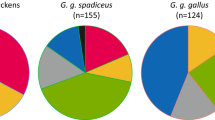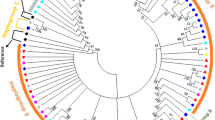Abstract
Local domestic chicken populations are of paramount importance as a source of protein in developing countries. Bangladesh possesses a large number of native chicken populations which display a broad range of phenotypes well adapted to the extreme wet and hot environments of this region. This and the fact that wild jungle fowls (JFs) are still available in some regions of the country, it urges to study the present genetic diversity and relationships between Bangladeshi autochthonous chicken populations. Here, we report the results of the mitochondrial DNA (mtDNA) sequence polymorphisms analyses to assess the genetic diversity and possible maternal origin of Bangladeshi indigenous chickens. A 648-bp fragment of mtDNA control region (D-loop) was analyzed in 96 samples from four different chicken populations and one red JF population. Sequence analysis revealed 39 variable sites that defined 25 haplotypes. Estimates of haplotype and nucleotide diversities ranged from 0.745 to 0.901 and from 0.011 to 0.016, respectively. The pairwise differences between populations ranged from 0.091 to 1.459 while most of the PhiST (ΦST) values were significant. Furthermore, AMOVA analysis revealed 89.16 % of the total genetic diversity was accounted for within population variation, indicating little genetic differentiation among the studied populations. The median network analysis from haplotypes of Bangladeshi chickens illustrated five distinct mitochondrial haplogroups (A, D, E, F and I). Individuals from all Bangladeshi chicken populations were represented in the major clades D and E; those maternal origins are presumed to be from Indian Subcontinent and Southeast Asian countries, more particularly from South China, Vietnam, Myanmar and Thailand. Further, phylogenetic analysis between indigenous chicken populations and sub-species of red JFs showed G. g. gallus and G. g. spadiceus shared with almost all haplogroups and had major influence than G. g. murghi in the origin of indigenous chicken of Bangladesh. These results suggest that Bangladeshi indigenous chickens still have abundant genetic diversity and have originated from multiple maternal lineages, and further conservation efforts are warranted to maintain the diversity.


Similar content being viewed by others
References
Fumihito A, Miyake T, Takada M, Shingu R, Endo T, Gojobori T, Kondo N, Ohno S (1996) Monophyletic origin and unique dispersal patterns of domestic fowls. Proc Natl Acad Sci USA 93:6792–6795
Kanginakudru S, Metta M, Jakati RD, Nagaraju J (2008) Genetic evidence from Indian red jungle fowl corroborates multiple domestication of modern day chicken. BMC Evol Biol 8:174
Liu Y-P, Wu G-S, Yao Y-G, Miao Y-W, Luikart G, Baig M, Beja-Pereira A, Ding Z-L, Palanichamy MG, Zhang Y-P (2006) Multiple maternal origins of chickens: Out of the Asian jungles. Mol Phylogenet Evol 38 (1):12–19. doi:http://dx.doi.org/10.1016/j.ympev.2005.09.014
Oka T, Ino Y, Nomura K, Kawashima S, Kuwayama T, Hanada H, Amano T, Takada M, Takahata N, Hayashi Y, Akishinonomiya F (2007) Analysis of mtDNA sequences shows Japanese native chickens have multiple origins. Animal Genet 38:287–293
Eriksson J, Larson G, Gunnarsson U, Bed’hom B, Tixier-Boichard M, Strömstedt L, Wright D, Jungerius A, Vereijken A, Randi E, Jensen P, Andersson L (2008) Identification of the yellow skin gene reveals a hybrid origin of the domestic chicken. PLoS Genet 4:e1000010
Nishibori M, Shimogiri T, Hayashi T, Yasue H (2005) Molecular evidence for hybridization of species in the genus Gallus except for Gallus varius. Animal Genet 36(5):367–375. doi:10.1111/j.1365-2052.2005.01318.x
Granevitze Z, Hillel J, Chen GH, Cuc NTK, Feldman M, Eding H, Weigend S (2007) Genetic diversity within chicken populations from different continents and management histories. Animal Genet 38(6):576–583. doi:10.1111/j.1365-2052.2007.01650.x
Halima H, Neser F, Van Marle-Koster E, De Kock A (2007) Village-based indigenous chicken production system in north-west Ethiopia. Trop Animal Health Prod 39:189–197
Bangladesh Bureau of Statistics (2008) Statistical yearbook. Bangladesh Bureau of Statistics, Dhaka
Maeda Y, Okada I, Hashiguchi T, Hasnath MA (1988) Blood protein polymorphism of native fowl and Red Jungle Fowl in Bangladesh. Rep Soc Res Nativ Livest 12:233–250
Bhuiyan AKFH, Bhuiyan MSA, Deba GK (2005) Indigenous chicken genetic resources of Bangladesh—current status and future outlook. Animal Genet Resour Inf 36:73–84
Crawford RD (1990) Origin and history of poultry species. In: Crawford RD (ed) Poultry breeding and genetics. Elsevier, New York, pp 317–329
Silva P, Guan X, Ho-Shing O, Jones J, Xu J, Hui D, Notter D, Smith E (2008) Mitochondrial DNA-based analysis of genetic variation and relatedness among Sri Lankan indigenous chickens and the Ceylon jungle fowl (Gallus lafayetti). Animal Genet 40:1–9
Muchadeyi FC, Eding H, Simianer H, Wollny CBA, Groeneveld E, Weigend S (2008) Mitochondrial DNA D-loop sequences suggest a Southeast Asian and Indian origin of Zimbabwean village chickens. Animal Genet 39:615–622
Mwacharo JM, Bjørnstad G, Mobegi V, Nomura K, Hanada H, Amano T, Jianlin H, Hanotte O (2011) Mitochondrial DNA reveals multiple introductions of domestic chicken in East Africa. Mol Phylogenet Evol 58:374–382
Revay T, Bodzsar N, Mobegi VE, Hanotte O, Hidas A (2010) Origin of Hungarian indigenous chicken breeds inferred from mitochondrial DNA D-loop sequences. Animal Genet 41:548–550
Librado P, Rozas J (2009) DnaSP v5: a software for comprehensive analysis of DNA polymorphism data. Bioinformatics 25:1451–1452
Excoffier L, Lischer HEL (2010) Arlequin suite ver 3.5: a new series of programs to perform population genetics analyses under Linux and Windows. Mol Ecol Resour 10:564–567
Bandelt HJ, Forster P, Röhl A (1999) Median-joining networks for inferring intraspecific phylogenies. Mol Biol Evol 16(1):37–48
Tamura K, Peterson D, Peterson N, Stecher G, Nei M, Kumar S (2011) MEGA5: molecular evolutionary genetics analysis using maximum likelihood, evolutionary distance, and maximum parsimony methods. Mol Biol Evol 28:2731–2739
Acknowledgments
We express our gratitude to the farmers for kindly providing the blood samples. MSAB and SC are recipients of Portuguese Foundation for science and Technology (FCT) postdoctoral grants SFRH/BPD/68896/2010 and SFRH/BPD/46082/2008, respectively. AB-P was funded by FCT, Programa Ciência.
Author information
Authors and Affiliations
Corresponding author
Electronic supplementary material
Below is the link to the electronic supplementary material.
Rights and permissions
About this article
Cite this article
Bhuiyan, M.S.A., Chen, S., Faruque, S. et al. Genetic diversity and maternal origin of Bangladeshi chicken. Mol Biol Rep 40, 4123–4128 (2013). https://doi.org/10.1007/s11033-013-2522-6
Received:
Accepted:
Published:
Issue Date:
DOI: https://doi.org/10.1007/s11033-013-2522-6




